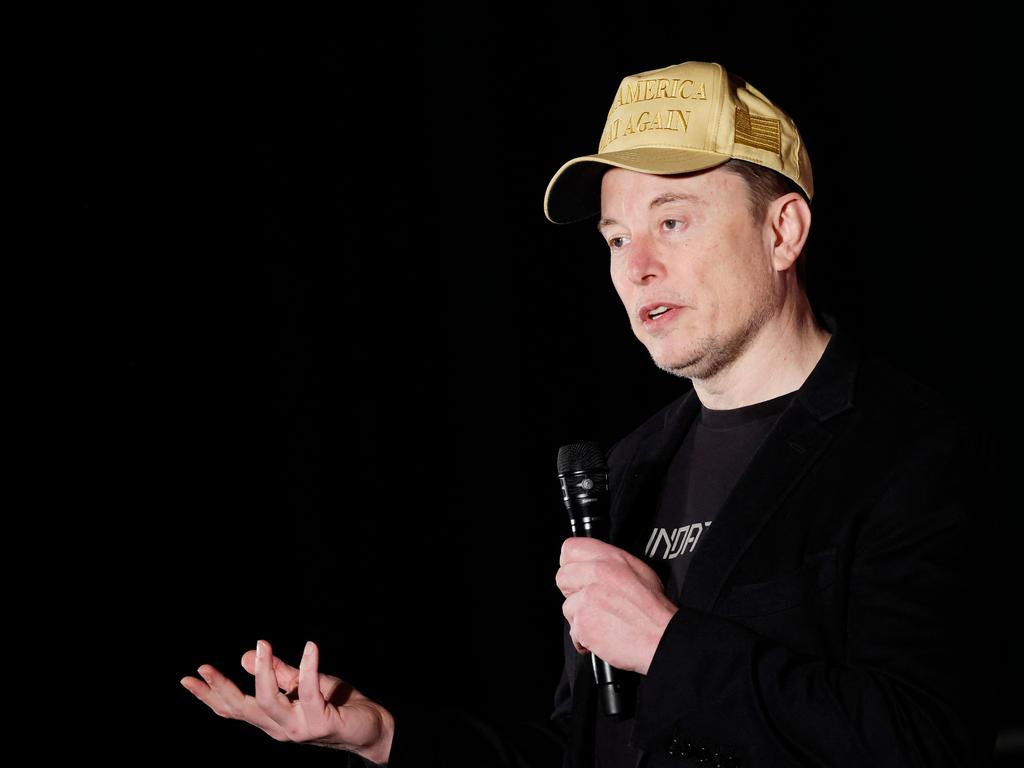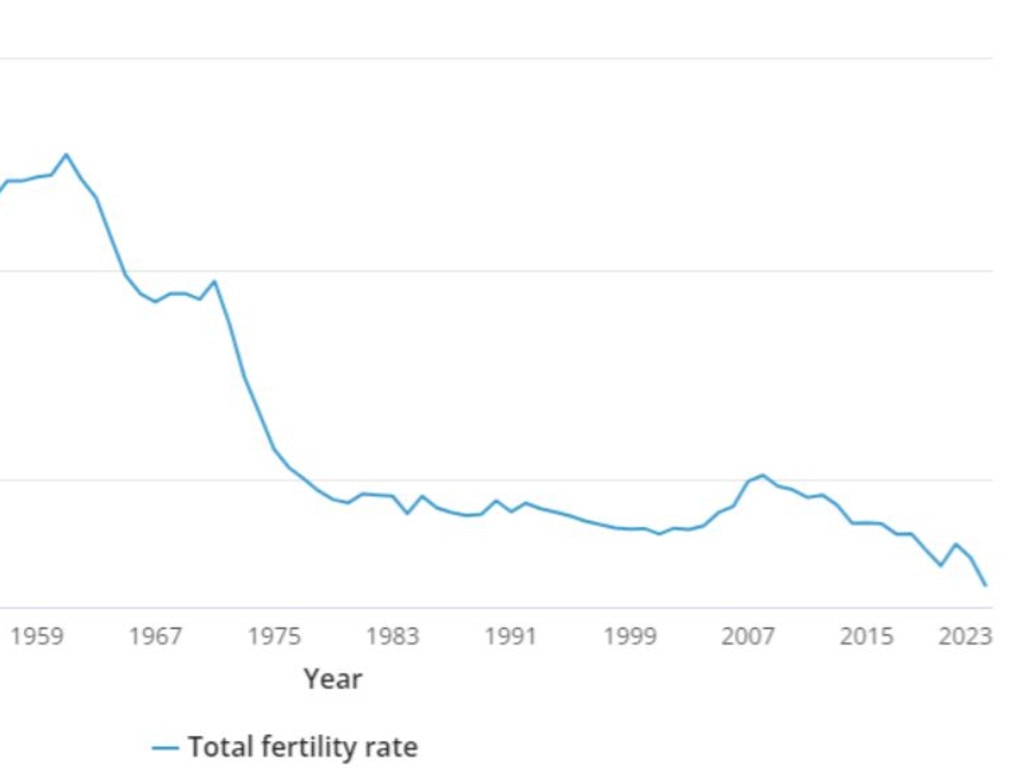Doomsday graph every Aussie must view as fertility rate plummets to record low
Australia’s fertility rate has sunk to a record low. Experts say there’s a few reasons women are having less babies - and a controversial solution to the crisis.

“I think the biggest problem the world will face in 20 years is population collapse,” Elon Musk ominously warned at an AI conference in 2019.
The billionaire, who has 12 children with three different women, later claimed “population collapse due to low birth rates” was a “much bigger risk to civilisation than global warming.”
While his dramatic prediction of a “population collapse” is rejected by most leading demographers, plummeting fertility rates in Western societies are starting to cause concern.
Data released by the Bureau of Statistics last week showed Australia registered 286,998 births in 2023, accounting for a fertility rate of 1.5 babies per woman – the lowest in history.
Experts say the ratio needs to be 2.1 babies per woman – a rate dubbed the “replacement level” – for society to sustain its population.
And Australia is not alone.
America, West Europe and East Asia are all experiencing similar downward trends with historically low fertility rates.
“Fertility is declining globally, with rates in more than half of all countries in 2021 below replacement level,” a recent global fertility study published in The Lancet revealed.
The paper predicted that just six countries in the world – Samoa, Somalia, Tonga, Niger, Chad and Tajikstan – would have a replacement level of fertility in 2100.
Half of the world’s babies are set to be born in sub-Saharan Africa at the turn of the century.

Grim reason for fertility rate - and a divisive solution
Demographer Amanda Davies said one of the main drivers of Australia’s plummeting fertility rates appeared to be “the cost of living and housing crisis facing many families.”
“Anecdotal evidence is amassing that younger people who do want families are foregoing having a family, delaying having a family or having a smaller family due primarily to current cost of living and housing concerns,” she told news.com.au.
Professor Davies, the head of social sciences at the University of Western Australia, said limitations in parental leave support and skyrocketing IVF costs were also major barriers.
KPMG urban economist Terry Rawnsley told The Nikkei there had been a “long-term, social shift away from families.”
“What we’ve seen over the past 24 months is that the cost of living crunch has really hit hard on people’s decisions to have children,” he added.
Professor Davies predicted Australia was likely to become “increasingly reliant” on migration to maintain its population in the future.
“If more support is not put in place to support families now, in two decades Australia will be more dependent on international migration than it currently is,” she said.
The demographer predicted there would be a “shift in the migrant intake” in Australia as populations continue to explode in North Africa and the Middle East.
“It’s unclear if this will result in Australia being more multicultural or if Australia will have larger concentrations of migrants from different backgrounds,” she said.
Pollster Kos Samaras said Australia’s falling birthrate “should not be a surprise”.
“Fifty-four per cent of 18-34-year-olds we interview report to us that they do not plan to have children,” he wrote on X on Thursday.
“The main drivers? Cost – housing.”

Natalia V Bhattacharjee, one of the co-authors of The Lancet report, said “reliance on open immigration” would become vital for shrinking nations “to sustain economic growth.”
“These future trends in fertility rates and live births will completely reconfigure the global economy and the international balance of power and will necessitate reorganising societies,” she told Al Jazeera.
Professor Davies acknowledged migration was a divisive issue in Australia.
“In looking to use migration as a strategy to address population growth issues, (the) government may also face complex challenges of addressing domestic concerns about migration,” she explained.
Last year, the Australian government vowed to halve its migration intake by 2025 – slashing the annual intake to 250,000 – in a bid to relieve pressure on the housing market.
It also tightened visa rules for international students.
How does this affect Australia’s economy?
In an article for The Conversation, three economics professors from RMIT University warned about the danger of fewer babies being born combined with an increased life expectancy.
“An ageing population means greater demand for medical services and aged care,” they wrote.
“As the working-age population shrinks, the tax base that funds these services will also decline.
“Unless this is offset by technological advances or policy innovations, it can mean higher taxes, longer working lives, or the government providing fewer public services in general.”
Professor Davies said the Australian government would need to “recruit talent from overseas as people from the Baby Boomer generation move into retirement.”
But experts say relying on immigration is “not a long-term solution.”
“The global fertility slump means that the pool of young, educated workers from other countries is shrinking, too,” the RMIT professors wrote in The Conversation.
“This makes it harder for Australia to attract the talent it needs to sustain economic growth.”

ANU demographer Liz Allen summed up the bleak situation, warning Australia was at a “crossroads.”
“This decline in the total fertility rate wouldn’t be so bad if it was what people were choosing, but this is not a free choice, this is a constrained choice,” she told The Nikkei.
“If (the birthrate) slips any further, we then have the experience of Japan and Singapore and South Korea, that really shows that then, once you hit (an) ultralow fertility rate, it is very difficult to arrest,” she said.
Japan has spent the past three decades trying – without success – to boost its devastatingly low fertility rate.
Despite a string of initiatives – including monthly allowances for parents, expanded childcare leave benefits and subsidised IVF treatments – its fertility rate fell to 1.20 last year.
Australia’s Deputy Prime Minister said the government was not looking at bringing back the baby bonus to boost the fertility rate.
The baby bonus - a $3000 lump sum payment for new parents - was introduced by the Howard government in 2004.
The initiative resulted in an uptick in births at the time, but experts aren’t convinced about its long-term benefits.
“We want to do what we can to make it easier for families and couples to have children and we are doing that. It is important that we have a sustainable birthrate,” Mr Marles told Seven’s Sunrise last week.
“A huge focus of the prime minister, the whole government has been on more affordable childcare, which makes a difference in terms of the ability to have children and raise children.
“It’s obviously an expensive thing to have kids, we all know that, but we are doing everything within our power to make that more affordable for Australians.”
Aussies weigh in on brutal fertility rate
A graph from the ABS - showing Australia’s declining fertility rate - triggered passionate debate after being shared on Reddit last week.
“I guess parents don’t want to move every one to two years with babies as they’re priced out of rentals,” was the top-liked response.
Another social media user said they hated the term “fertility”.
“It puts the onus on women/couples, as if something’s wrong, as if it’s their fault. This has little to do with fertility,” they wrote.
“I suspect Aussies are plenty fertile, they’re choosing not to because of a host of reasons; to call it fertility and their fault neglects the sh***y choices politicians and businesses have made that create the social, economic and environmental conditions that dissuade one from condemning their kids to a sh***y future.”
Another said the graph was proof Australia needed to bring back the baby bonus and make childcare more affordable.
Others suggested shifting cultural norms and changing life priorities were behind the falling fertility rate.
“I think young people have different goals now too,” wrote one social media user.
“Back in the day you got married and raised a family. These days, people are influenced by hundreds of images daily of people travelling overseas, new makeup, self-care products, clothing.
“You're not thinking about having kids in your early 20s. You want to be out spending it up, living your best life!”




